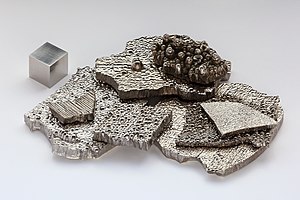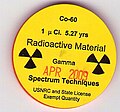|
| Appearance |
|---|
कठोर चमकीली नीला-ग्रे धातु
 |
| General |
|---|
| Name, symbol, number | कोबाल्ट (cobalt), Co, 27 |
|---|
| Group, period, block | 9, 4, d |
|---|
| Standard atomic weight | {{{atomic mass}}} g·mol−1 |
|---|
| Electron configuration | {{{electron configuration}}} |
|---|
| Electrons per shell | 2, 8, 15, 2 (Image) |
|---|
| Physical properties |
|---|
| Density (near r.t.) | 8.90 g·cm−3 |
|---|
| Liquid density at m.p. | 8.86 g·cm−3 |
|---|
| Melting point | 1768 K, 1495 °C, 2723 °F |
|---|
| Boiling point | 3200 K, 2927 °C, 5301 °F |
|---|
| Heat of fusion | 16.06 kJ·mol−1 |
|---|
| Heat of vaporization | 377 kJ·mol−1 |
|---|
| Specific heat capacity | (25 °C) 24.81 J·mol−1·K−1 |
|---|
| Vapor pressure |
|---|
| P/Pa | 1 | 10 | 100 | 1 k | 10 k | 100 k | | at T/K | 1790 | 1960 | 2165 | 2423 | 2755 | 3198 |
|
| Atomic properties |
|---|
| Electronegativity | 1.88 (Pauling scale) |
|---|
Ionization energies
(more) | 1st: {{{1st ionization energy}}} kJ·mol−1 |
|---|
| 2nd: {{{2nd ionization energy}}} kJ·mol−1 |
| 3rd: {{{3rd ionization energy}}} kJ·mol−1 |
| Atomic radius | 125 pm |
|---|
| Covalent radius | Low spin: 126±3 pm
High spin: 150±7 pm |
|---|
| Miscellaneous |
|---|
| Crystal structure | hexagonal close packed |
|---|
| Magnetic ordering | लौहचुम्बकीय |
|---|
| Electrical resistivity | (20 °C) 62.4Ω·m |
|---|
| Thermal conductivity | (300 K) 100 W·m−1·K−1 |
|---|
| Thermal expansion | (25 °C) 13.0 µm·m−1·K−1 |
|---|
| Speed of sound (thin rod) | (20 °C) 4720 m/s |
|---|
| Young's modulus | 209 GPa |
|---|
| Shear modulus | 75 GPa |
|---|
| Bulk modulus | 180 GPa |
|---|
| Poisson ratio | 0.31 |
|---|
| Mohs hardness | 5.0 |
|---|
| Vickers hardness | 1043 MPa |
|---|
| Brinell hardness | 470–3000 MPa |
|---|
| CAS registry number | 7440-48-4 |
|---|
| Most stable isotopes |
|---|
| Main article: Isotopes of कोबाल्ट (cobalt) |
|
|
कोबाल्ट (प्रतीक : Co) एक रासायनिक तत्व है जिसका परमाणु क्रमांक २७ है। यह संक्रमण धातु है। अपने शुद्ध रूप में यह धातु कठोर, चमकीली और सलेटी-चाँदी रंग की होती है, लेकिन निकिल की भांति कोबाल्ट भी पृथ्वी के गर्भ में केवल अन्य रासायनिक तत्वों के साथ बने यौगिकों के रूप में ही मिलती है। कुछ मात्रा में पृथ्वी पर गिरे उल्काओं में यह शुद्ध रूप में प्राप्त होती है।[1]
उपयोग
कोबाल्ट-आधारित नीले वर्णक (पिगमेंट) हजारों वर्षों से मानवों द्वारा प्रयोग होते आ रहें हैं जिनका उपयोग प्रायः दर्पणों को नीला रंग देने के लिये किया जाता रहा है। इसे बर्तनों, प्यालों, स्याही व अन्य वस्तुओं को भी रंगने के लिये प्रयोग किया जाता है। आधुनिक काल में आधिकतर कोबाल्ट खनिज अफ़्रीका के कांगो लोकतान्त्रिक गणराज्य और ज़ाम्बिया देशों में खानों से निकाला जाता है। तीव्र लौहचुम्बकत्व का गुण रखने वाला यह तत्व अत्यन्त चुम्बकीय होता है और उद्योग में इसका प्रयोग एक चुम्बकीय और कठोर धातु के गुणों के कारण किया जाता है। मनुष्य-सहित कई अन्य जीवों को जीवन के लिये अल्प मात्रा में कोबाल्ट-युक्त आहार खाने की आवश्यकता है।[2][3]
उत्पादन
सन २०१७ में कोबाल्ट का कुल उत्पादन और भण्डार[4]| देश | उत्पादन (टन) | भण्डार (टन) |
|---|
 DR Congo DR Congo | 64,000 | 3,500,000 |
 Russia Russia | 5,600 | 250,000 |
 Australia Australia | 5,000 | 1,200,000 |
 Canada Canada | 4,300 | 250,000 |
 Cuba Cuba | 4,200 | 500,000 |
 Philippines Philippines | 4,000 | 280,000 |
 Madagascar Madagascar | 3,800 | 150,000 |
 Papua New Guinea Papua New Guinea | 3,200 | 51,000 |
 Zambia Zambia | 2,900 | 270,000 |
 New Caledonia New Caledonia | 2,800 | - |
 South Africa South Africa | 2,500 | 29,000 |
 United States United States | 650 | 23,000 |
| अन्य देश | 5,900 | 560,000 |
| विश्व का कुल | 110,000 | 7,100,000 |
चित्र
इन्हें भी देखें
सन्दर्भ
- ↑ Dennis, W. H (2010). "Cobalt". Metallurgy: 1863–1963. pp. 254–256. ISBN 978-0-202-36361-5.
- ↑ Wang, Shijie (2006). "Cobalt—Its recovery, recycling, and application". Journal of the Minerals, Metals and Materials Society 58 (10): 47–50. Bibcode:2006JOM....58j..47W. doi:10.1007/s11837-006-0201-y.
- ↑ Murthy, V. S. R (2003). "Magnetic Properties of Materials". Structure And Properties Of Engineering Materials. p. 381. ISBN 978-0-07-048287-6.
- ↑ Cobalt Statistics and Information (PDF), U.S. Geological Survey, 2018, मूल से 10 जनवरी 2019 को पुरालेखित (PDF), अभिगमन तिथि 7 जनवरी 2019

 कोबाल्ट खनिज
कोबाल्ट खनिज 'ब्रिस्टल ब्लू' नामक शीशे का काम कोबाल्ट से रंगित होता है
'ब्रिस्टल ब्लू' नामक शीशे का काम कोबाल्ट से रंगित होता है इन भेड़ों में कोबाल्ट की कमी होने से इनकी यह दशा हुई है।
इन भेड़ों में कोबाल्ट की कमी होने से इनकी यह दशा हुई है। कोबाल्ट-६० रेडियोसक्रिय होता है। इससे निकले हुए गामा किरणों से खाद्य पदार्थों को विकिरित किया जाता है, जिससे उन पर स्थित रोगाणु अपनी संख्या नहीं बढ़ा पाते।
कोबाल्ट-६० रेडियोसक्रिय होता है। इससे निकले हुए गामा किरणों से खाद्य पदार्थों को विकिरित किया जाता है, जिससे उन पर स्थित रोगाणु अपनी संख्या नहीं बढ़ा पाते।